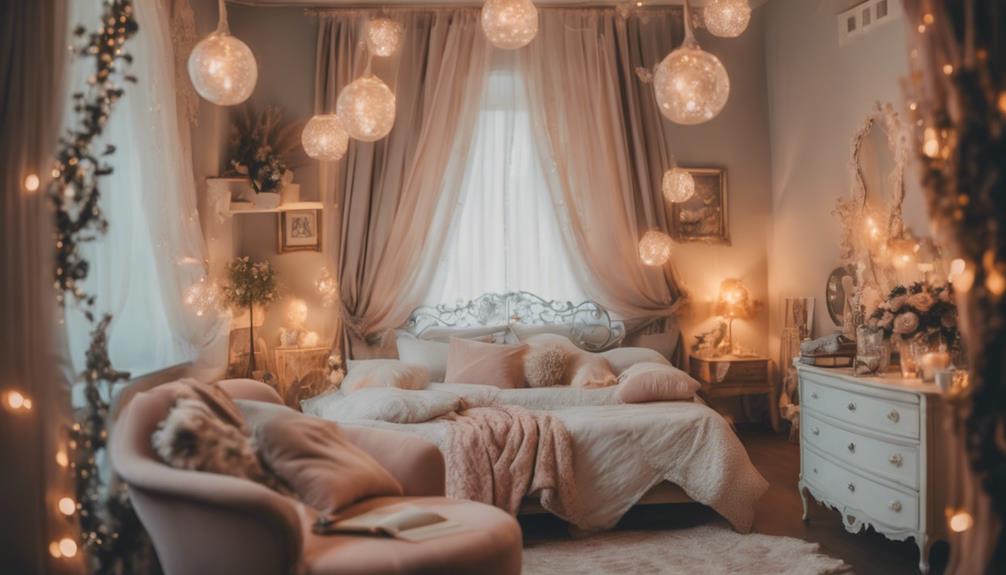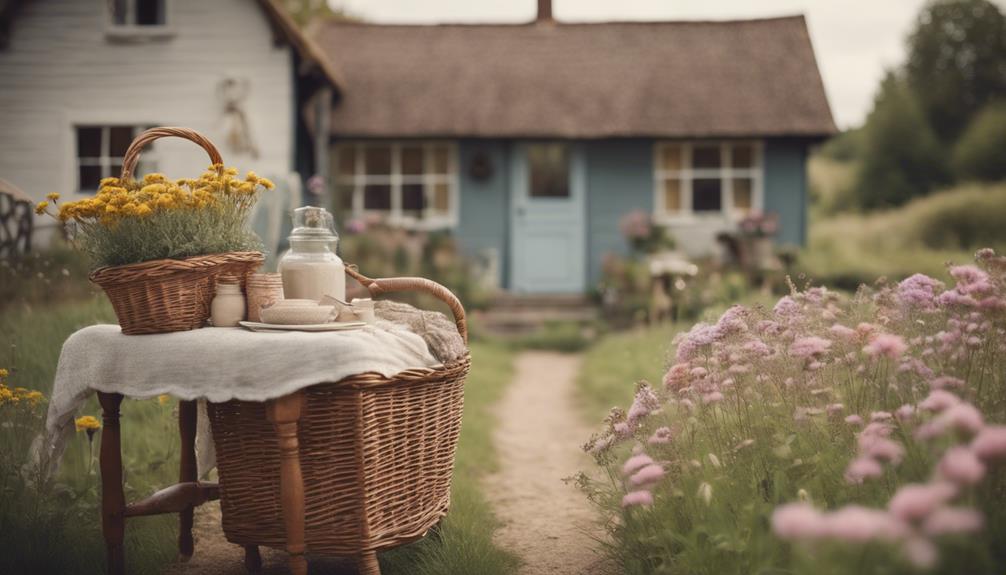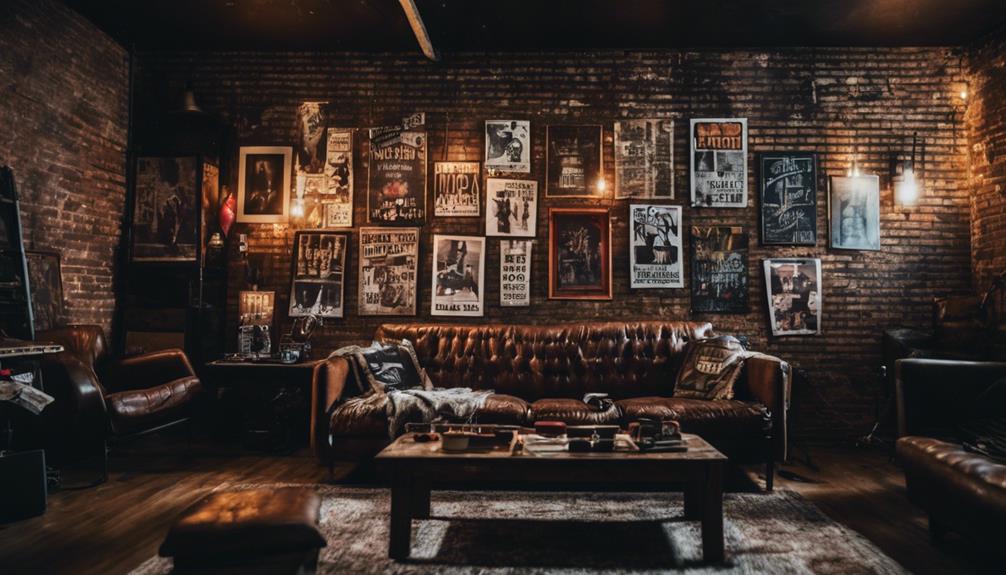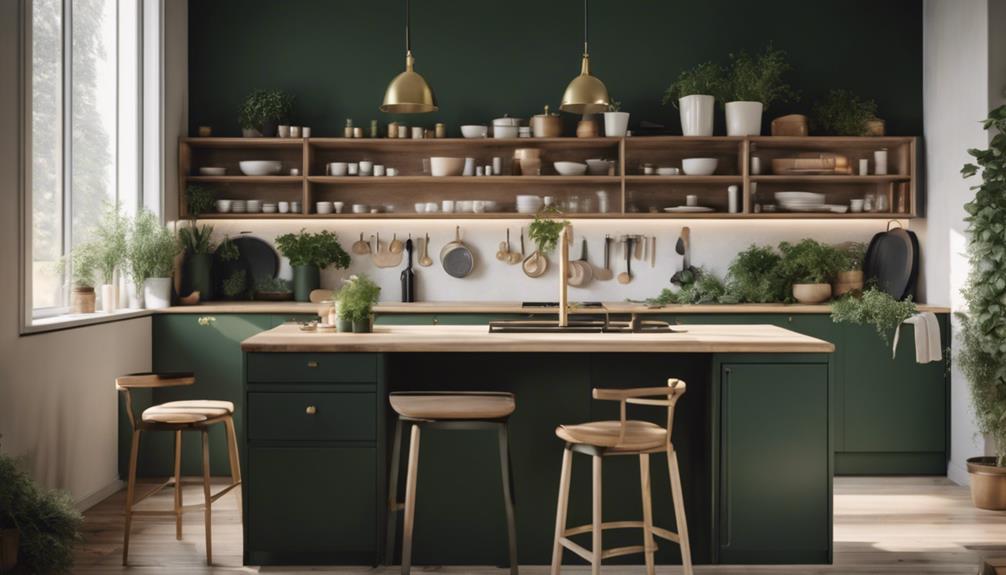You can easily transform your space into an enchanting retreat by blending aesthetic and coquette room decor. Start with a soft color scheme of pastel pinks, creams, and subtle metallics. Incorporate vintage furniture, like an elegant vanity table, alongside chic accent chairs for a cozy vibe. Layer textures with lace curtains and plush velvet pillows for added romance. Opt for dreamy lighting options, such as crystal chandeliers and twinkling fairy lights, to set the mood. Don't forget decorative elements like porcelain figurines and floral art to personalize your space. Discover more tips to make your room truly magical!
Key Elements
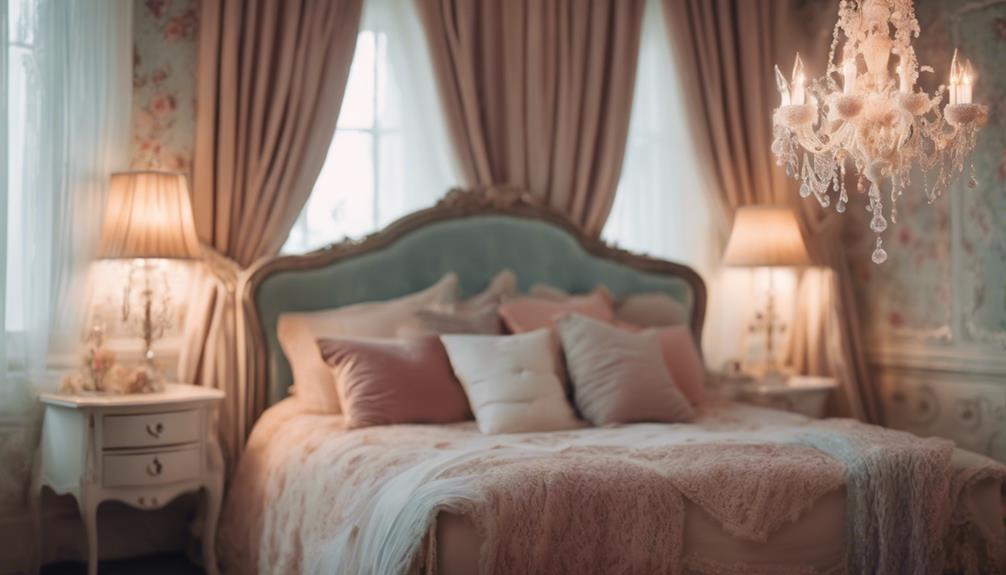
When creating your coquette room, you'll want to focus on the color scheme, materials, and textures that define this aesthetic.
Soft pastels and plush fabrics can transform your space into a romantic haven.
Color Scheme
The coquette aesthetic thrives on a color scheme that blends soft pastels like blush and cream with elegant metallic accents for a sophisticated yet playful vibe.
When you're curating your color palette, consider foundational colors such as soft pinks, whites, and muted tones that create a warm and inviting atmosphere. Light blues and greens can refresh the space, enhancing the romantic elements synonymous with coquette style.
To add depth, incorporate darker shades like burgundy strategically; they provide contrast and can highlight specific decor items. Metallic accents—think gold or silver—work beautifully to elevate the overall look, adding a touch of glamour without overwhelming the softness of your chosen hues.
Don't shy away from mixing patterns and layering textures within your color scheme; it's essential for expressing creativity while maintaining a cohesive aesthetic.
This playful approach allows you to personalize your space, making it uniquely yours. By carefully selecting your colors and decor items, you can achieve a stylish and romantic space that embodies the essence of the coquette aesthetic.
Materials
Soft textiles like lace and ruffles play an essential role in coquette room decor, infusing the space with a romantic and feminine touch.
You'll want to choose curtains, cushions, and throws that feature these soft textiles, creating a cozy and inviting atmosphere. Vintage furniture pieces, such as ornate dressers and plush armchairs, add character and a nostalgic flair, making your room feel timeless and chic.
To tie everything together, focus on a color palette that includes soft pastels, blush tones, and creamy whites.
These gentle hues can be accented with metallics to bring a touch of elegance and sophistication.
Incorporating decorative elements like whimsical vases or floral wallpapers enhances the playful nature of the coquette style.
Consider adding DIY projects too; upcycling thrifted items or creating custom pillow covers allows you to personalize your space while embracing its charm.
Textures
Incorporating a variety of textures, like lace curtains, velvet pillows, and crochet bed skirts, creates an enchanting and romantic ambiance in your coquette room decor. These elements enhance the feminine atmosphere, making the space feel cozy and inviting.
Layering different materials, such as floral-patterned fabrics and knitted throws, adds depth and visual interest, while ensuring everything maintains a cohesive look.
Don't forget to include delicate accents like ruffled bedding and embroidered heart-shaped pillows. These whimsical touches contribute to the overall softness and playful charm that defines coquette design.
To further elevate your space, consider incorporating antique or vintage furniture pieces with intricate details. They introduce unique textures that complement the nostalgic elements of this aesthetic.
Essential Fixtures and Furniture
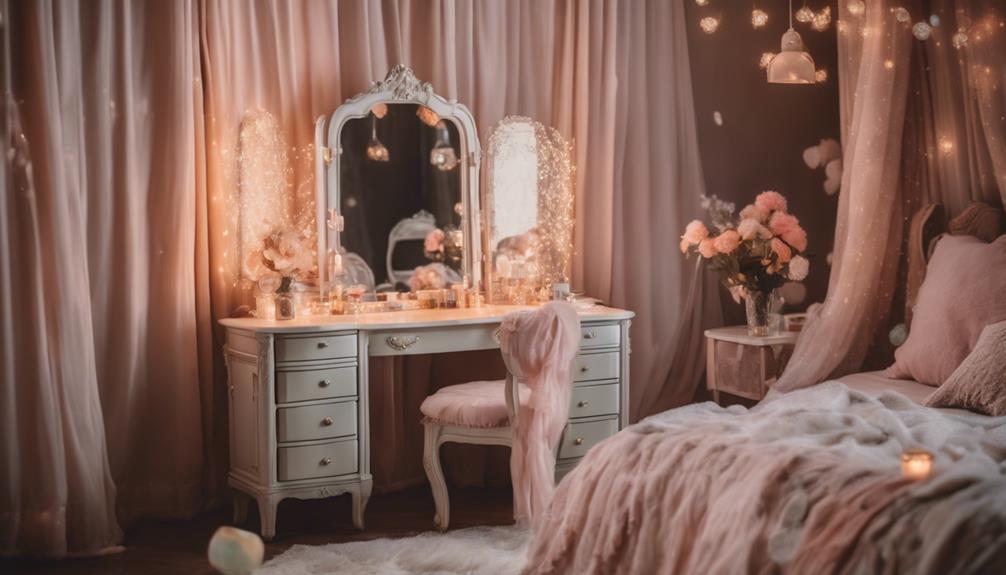
To create a truly coquette-inspired space, you need to focus on essential fixtures and furniture that embody charm and elegance.
A vintage vanity table can serve as a stunning focal point, while a chic accent chair adds both style and comfort.
Don't forget lush velvet throw pillows, as they provide a perfect touch of luxury and warmth to your decor.
Vintage Vanity Table
A vintage vanity table serves as a stunning centerpiece in coquette room decor, showcasing intricate designs that elevate the feminine charm of your space. This essential fixture not only adds elegance but also enhances functionality, making it perfect for your daily beauty routines.
To create a cohesive look, consider incorporating a vintage mirror above the vanity; it reflects light and adds depth, making your coquette aesthetic room feel larger and brighter.
For decor ideas, accessorize your vintage vanity table with heart-shaped or floral jewelry holders to keep your personal items organized while adding a touch of whimsy. A plush chair or stool upholstered in soft fabrics or pastel colors will provide a comfortable spot for getting ready, seamlessly blending comfort with style.
Don't forget to decorate the vanity with charming elements like vintage perfume bottles, delicate floral arrangements, or personal artwork to personalize your space. These touches not only enhance the romantic feel of the room but also express your unique style.
In a coquette aesthetic room, your vintage vanity table acts as a perfect blend of beauty and functionality, making it a true focal point in your decor.
Chic Accent Chair
A chic accent chair acts as both a stylish statement and a cozy seating option in your coquette-themed room. Choosing a plush armchair or a Victorian-style chaise lounge adds that perfect touch of elegance. Look for soft upholstery in pastel shades or floral patterns, which effortlessly blend with the aesthetic while embracing things feminine.
To enhance the romantic feel of your space, consider vintage-inspired chairs with ornate detailing or delicate legs. These pieces can serve as a focal point, drawing attention and admiration. Incorporating decorative pillows with playful designs invites a layer of texture and comfort, making your accent chair even more inviting.
Position your chic accent chair near a window or under soft lighting to craft an inviting reading nook. This arrangement not only romanticizes vintage summer vibes but also creates a perfect spot for self-love and relaxation.
Lush Velvet Throw Pillows
Chic accent chairs become even more inviting when adorned with lush velvet throw pillows that add texture and a touch of luxury to your coquette room decor. These pillows, available in soft blush, cream, and pastel tones, perfectly complement the romantic aesthetic you're aiming for. Their rich fabric not only enhances comfort but also brings a sense of elegance to your space.
To elevate the feminine charm of your decor, consider incorporating decorative elements like ruffles or embroidery on your velvet pillows. These details accentuate the coquette style and infuse your room with personality. Layering these plush pillows with other fabrics, such as lace or floral prints, creates a cozy atmosphere that invites relaxation.
Don't shy away from mixing various sizes and shapes of lush velvet throw pillows. This playful arrangement encourages creativity while enhancing both comfort and visual appeal on your sofas or beds. By thoughtfully selecting and arranging these pillows, you'll create a beautifully curated space that embodies the essence of coquette room decor, making every corner feel romantic and inviting.
Lighting Ideas
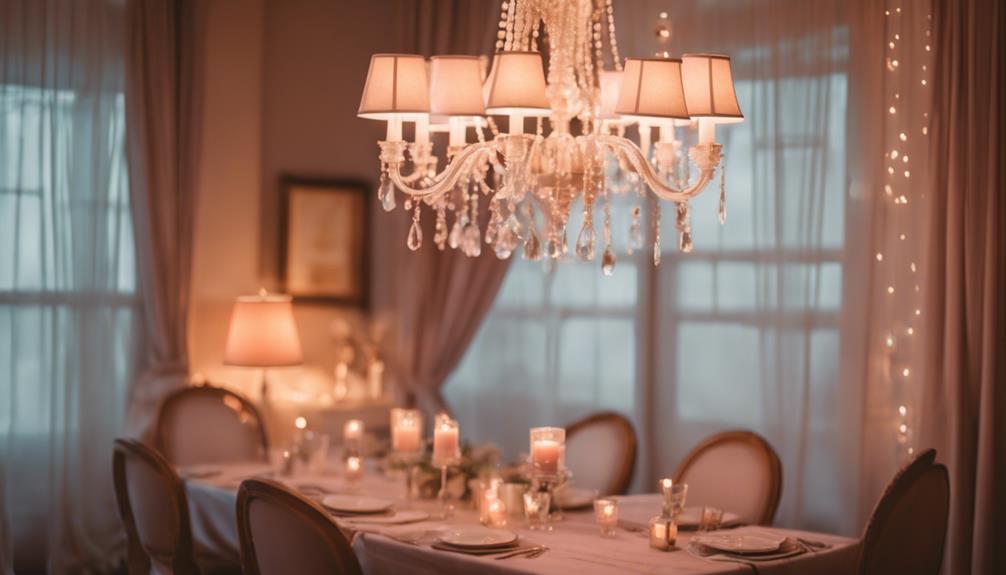
When it comes to lighting your coquette room, you'll want to create a blend of charm and warmth.
Start by considering a stunning chandelier with crystals for that elegant focal point, and don't forget soft pink table lamps to add a touch of sweetness.
Twinkling fairy lights and romantic candlelit wall sconces can elevate the atmosphere, making it truly inviting.
Charming Chandelier With Crystals
Transforming your space with a charming chandelier adorned with crystals instantly elevates the romantic ambiance of a coquette-inspired room. This stunning focal point reflects light beautifully, enhancing your aesthetic room decor while creating a cozy, intimate atmosphere.
Crystal chandeliers come in various styles, so you can easily find one that matches your coquette aesthetic, whether you prefer vintage-inspired designs or modern interpretations. Look for options that feature scalloped or fringe detailing—these playful elements add a feminine touch that perfectly aligns with coquette themes.
When you install a chandelier, you'll notice how it elevates the elegance of your space, making it feel more luxurious and inviting. Additionally, consider incorporating dimmable lighting options within your chandelier fixture. This feature lets you easily adjust the mood, whether you're hosting a romantic dinner or enjoying a quiet evening at home.
With the right charming chandelier, you'll create an enchanting environment that embodies the essence of coquette style, bringing warmth and charm to your aesthetic room decor.
Soft Pink Table Lamps
Soft pink table lamps bring a warm, inviting glow to your coquette room decor, perfectly enhancing its romantic and feminine atmosphere. These lamps not only serve as functional lighting but also as stylish decor elements that contribute to the overall elegance of your space.
Look for designs featuring scalloped edges or fringed details; they align beautifully with the playful essence of the coquette aesthetic. To elevate the charm even further, consider lamps with crystal or gold accents. These materials add a touch of sophistication, making your room feel more polished and inviting.
Position your soft pink table lamps on vintage side tables or dressers to create cozy focal points that draw the eye and encourage relaxation. Additionally, choose lamps with adjustable brightness. This feature allows you to easily shift from bright light for reading or tasks to a softer glow for a tranquil ambiance.
With the right placement and style, soft pink table lamps won't only illuminate your space but also enhance the romantic allure of your coquette room decor, creating a truly enchanting environment.
Twinkling Fairy Lights Garland
Twinkling fairy lights garlands add a whimsical touch to your coquette room, creating a warm and inviting glow that enhances its romantic ambiance. These enchanting lights are often available in soft pastel colors like pink and cream, perfectly complementing the coquette aesthetic. You can easily drape them over furniture, hang them along walls, or arrange them in playful shapes to craft visually interesting focal points throughout the space.
Using battery-operated fairy lights means you can place them anywhere without worrying about nearby electrical outlets. This versatility allows you to create enchanting displays that suit your style. Consider incorporating twinkling fairy lights into decorative elements, such as floral arrangements or vintage mirrors. This not only enhances their charm but also contributes to a dreamy, inviting atmosphere.
To make the most of your fairy lights, experiment with different arrangements and placements until you find what feels right for your coquette room. The soft glow of twinkling fairy lights will elevate your space, making it the perfect backdrop for cozy evenings or romantic moments. Embrace the magic they bring to your decor!
Romantic Candlelit Wall Sconces
Romantic candlelit wall sconces bring a touch of elegance to your coquette room, casting a warm glow that invites intimacy and charm. These sconces enhance the coquette decor by providing soft warm lighting that creates an inviting atmosphere. Look for sconces with delicate designs, like floral patterns or graceful curves, which perfectly complement the feminine and vintage elements of your space.
Consider using materials like wrought iron or crystal for your sconces, as they add sophistication and style. Strategically place these romantic candlelit wall sconces near mirrors or artwork to reflect light and amplify the overall ambiance. This reflection not only brightens the room but also highlights your decor beautifully.
Don't forget to incorporate scented candles in your sconces. The gentle flicker of candlelight combined with delightful fragrances elevates the sensory experience, making your coquette room even cozier and more inviting.
Decorative Elements
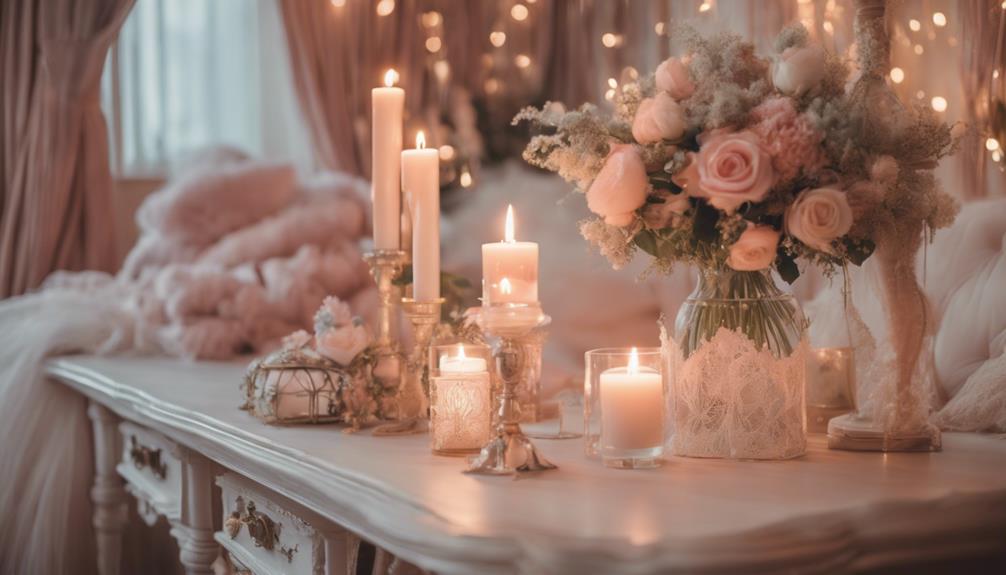
To truly embrace the coquette aesthetic, you'll want to incorporate decorative elements like delicate porcelain figurines and framed floral artwork.
These pieces not only add character but also enhance the romantic vibe of your space.
A vintage floral tabletop mirror can further reflect your style while creating an inviting atmosphere.
Delicate Porcelain Figurines
Delicate porcelain figurines add a charming touch to your coquette aesthetic room, enhancing its feminine and nostalgic vibe. These exquisite pieces often depict classic themes, such as cherubs, flowers, or whimsical animals, injecting both elegance and playfulness into your decor.
To make the most of these figurines, display them on vintage side tables or ornate shelves. This not only creates focal points that draw the eye but also complements your room's color palette beautifully. Consider collecting unique or antique porcelain pieces from thrift stores or flea markets to personalize your space and reflect your individual style.
Incorporating delicate porcelain figurines alongside soft lighting, like fairy lights or a vintage lamp, can further elevate the romantic atmosphere of your room. The warm glow of the light will enhance the delicate details of the figurines, creating an inviting ambiance perfect for relaxation or intimate gatherings.
Framed Floral Artwork
Framed floral artwork enhances your coquette room's charm, infusing it with femininity and elegance. This central decorative element not only brightens your space but also adds a personal touch that reflects your style.
When selecting your framed floral artwork, consider choosing vintage or whimsical frames that perfectly complement the coquette decor aesthetic. These frames can provide a stylish contrast to the vibrant floral prints, making them stand out even more.
Incorporating a variety of floral patterns and colors will create visual interest, harmonizing beautifully with the soft pastel palette typical of coquette decor. You can experiment with different sizes of artwork to create depth and dimension in the room, drawing attention to specific areas while maintaining a cohesive look.
Arranging your framed floral artwork in clusters or as a gallery wall allows for creativity and personalization, ensuring your space feels uniquely yours. By thoughtfully curating your floral artwork, you'll not only enhance the overall charm of your coquette room but also create a romantic atmosphere that invites relaxation and enjoyment.
Vintage Floral Tabletop Mirror
A vintage floral tabletop mirror instantly elevates your coquette room's decor with its charming and ornate design, reflecting both beauty and style. This decorative element enhances the coquette aesthetic by incorporating delicate, feminine details, often featuring intricate frames adorned with lovely floral patterns. Not only does it serve functional purposes, allowing you to check your appearance, but it also adds depth and charm to your space.
You can easily find a vintage floral tabletop mirror at thrift stores or online marketplaces, making it an affordable option to enhance your room's aesthetic. When placed on vanities or dressers, it becomes an ideal accessory to showcase beauty products and other decorative elements, creating a cohesive and inviting atmosphere.
Moreover, the soft reflections from the mirror beautifully capture the ambient light characteristic of coquette decor, making the space feel warm and romantic. Its floral designs can also tie together various color palettes, complementing the soft pastels or muted tones you might prefer.
With a vintage floral tabletop mirror, you'll effortlessly add a touch of elegance and charm to your coquette-inspired space.
Flooring
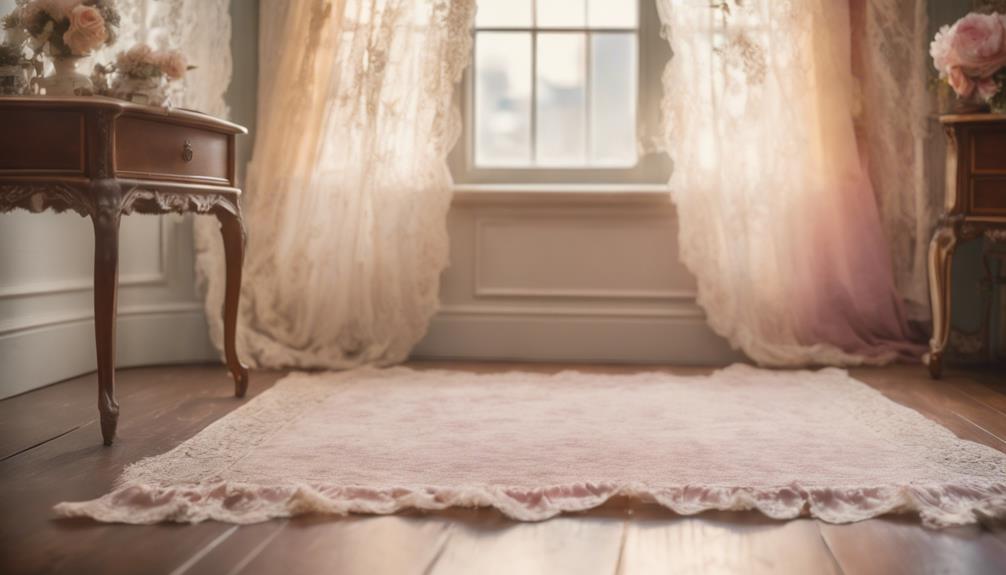
When choosing flooring for your coquette room, think about how it can enhance the overall aesthetic.
A soft, patterned area rug can add warmth, while polished hardwood paired with a lace runner offers a chic contrast.
Don't overlook textured boucle carpet, which adds depth and comfort, perfectly aligning with your decor style.
Soft, Patterned Area Rug
Soft, patterned area rugs in pastel colors can transform your coquette-themed room into a cozy haven, instantly adding warmth and texture. When selecting a soft, patterned area rug, look for floral or lace designs that enhance the feminine aesthetic. These patterns complement other decor elements like cushions and curtains, creating a harmonious space that feels inviting.
Choosing a plush, fluffy rug not only elevates the comfort level but also aligns perfectly with the coquette aesthetic's emphasis on self-love and relaxation. Layering your patterned area rug over a neutral flooring option can introduce depth and interest, allowing you to express your creativity through color and design.
For an elegant touch, consider a rug with a subtle sheen or metallic threads. This detail can beautifully harmonize with the soft colors and vintage charm typical of the coquette aesthetic.
By incorporating a soft, patterned area rug into your decor, you're not just adding a flooring piece; you're creating a focal point that enhances the overall ambiance of your romantic space.
Enjoy the blend of style and comfort as you step into your charming retreat!
Polished Hardwood With Lace Runner
Polished hardwood floors create a timeless foundation for your coquette aesthetic, enhancing the space's warmth and charm. The natural shine of these floors serves as an elegant backdrop, allowing you to play with textures and colors throughout your decor.
To elevate this look further, consider adding a lace runner atop your polished hardwood floors. This delicate addition introduces a romantic flair that beautifully complements the soft, muted color palette typical of coquette decor.
Lace runners come in various designs, so you can easily find one that aligns with the floral and vintage themes prevalent in coquette aesthetics. This combination of polished hardwood and lace creates a striking contrast, highlighting the playful yet sophisticated nature of your space.
Plus, maintaining the shine of your hardwood is essential; a well-kept surface not only enhances visual appeal but also reflects the soft lighting that sets the mood in coquette-inspired rooms.
Textured Boucle Carpet
Textured boucle carpet transforms your coquette-inspired space with its inviting softness and unique visual depth. Made from looping yarns, this type of carpet enhances comfort, making your room feel warm and welcoming. Its rich texture adds a layer of interest that beautifully complements the soft pastel color palette typical of the coquette aesthetic.
You'll find textured boucle carpets in various colors and patterns, allowing you to choose options that align perfectly with the romantic and feminine elements of your decor. This versatility guarantees you can create a cohesive look that reflects your personal style.
Beyond aesthetics, boucle carpet is durable, meaning it can handle daily use while maintaining its stylish appearance. This durability is essential for fostering a cozy atmosphere, as it invites you to lounge and relax in your beautifully curated space.
Incorporating a textured boucle carpet not only enhances the overall warmth of your room but also becomes an essential element in achieving the inviting ambiance characteristic of the coquette aesthetic. So, consider this lovely flooring option to elevate your decor and create a truly enchanting environment.
Conclusion
By blending aesthetic and coquette room decor, you can effortlessly create a stylish and romantic space that reflects your personality. Incorporate soft, pastel colors, vintage-inspired furniture, and delicate floral patterns to achieve a coquette room decor. Add touches of whimsy with charming, feminine accents such as lace, ruffles, and dainty decorations. For a more relaxed and rustic vibe, consider mixing in some cozy cottagecore room decor with natural textures, earthy tones, and a touch of nostalgic charm. With the right combination of these elements, you can transform any room into a beautiful and inviting space that feels both elegant and cozy.
Focus on key elements, choose essential fixtures and furniture, and don't forget about lighting to set the mood.
Incorporate decorative elements that speak to your taste, and select flooring that complements your theme.
With these tips, you'll transform your room into a dreamy retreat that invites relaxation and inspiration.
Happy decorating!
